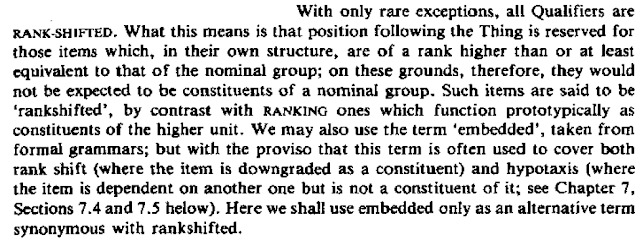Fawcett (2010: 189):
Furthermore, in the brief section in IFG on 'rank shift', Halliday quickly introduces the terms embedding and embedded as alternatives to "rank" and "rankshifted", and he then drops the original two terms completely. So it seems that Halliday himself appears to prefer the terms "embedding" and "embedded". (This is my preference too — but Halliday would not share the reason for my preference, which is that the term "embedding" expresses the key concept in the new theory that a unit frequently occurs within a unit of the same class without invoking the notion of the 'rank scale'. Again, see Section 11.1 of Chapter 11).
Blogger Comments:
[1] To be clear, what Halliday (1994: 188) actually writes is:
[2] To be clear, as can be seen in the quote above, Fawcett here confuses the notion of 'rank', a level in the rank scale of forms, with 'ranking', the status of a form that is not rankshifted.
[3] This is misleading. As can be seen from the quote above, Halliday does not "drop these terms completely". Instead, he explains that he uses the term 'embedded' only as an alternative to 'rank-shifted', excluding 'hypotaxis'. The reader is invited to predict whether or not Fawcett's use of 'embedded' includes the notion of 'hypotaxis'.
[4] This is misleading, because it flatly contradicts the Halliday quote, as can be seen above.
[5] To be clear, this proposition is not discussed in Section 11.1, as will be seen when Chapter 11 is examined.

No comments:
Post a Comment